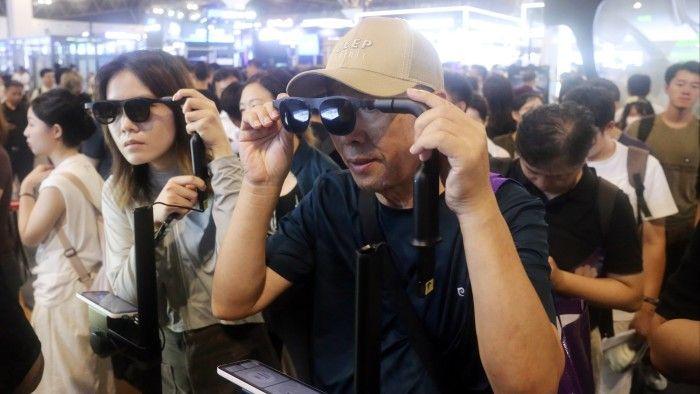Smart Glasses Race Heats Up as Chinese Companies Challenge Meta's Dominance with Affordable AI-Powered Models
2 Sources
2 Sources
[1]
Can smart glasses ever earn our trust?
Imagine being able to read a foreign language through artificial intelligence-powered smart glasses, watching it translated before your eyes. That is the experience Alibaba is offering with its new AI-powered eyewear, as Chinese tech groups race to make smart glasses practical and affordable after years of false starts. Priced at around $560 after discounts, Alibaba's Quark AI glasses undercut what Apple or Meta are expected to charge for their upcoming models. That price tag could prove decisive in determining whether smart glasses finally move beyond hype and into real world use. For more than a decade, the big obstacle facing smart glasses has been human discomfort. People do not want to be filmed as they go about their daily lives. Google Glass, for example, failed to gain traction because it made bystanders uneasy. The idea that someone nearby may be recording without our knowledge contributed to the public's rejection of early augmented reality devices. It remains the obstacle that the makers of smart glasses cannot escape. But companies that are investing heavily in the products such as Alibaba, Xiaomi, Huawei, Tencent and Baidu are now seeking to overcome consumer resistance by emphasising their utility. The key focus in recent developments has been on real time translation, voice assistance, navigation cues and sports metrics. While most current models still include cameras, the next generation may increasingly drop video functions as privacy concerns and consumer preferences push the market towards non-recording designs. For now, innovation in smart glasses remains inseparable from geopolitics. Western regulators and consumers remain concerned about Chinese data practices. Beijing's own cyber security and data security laws include state oversight of local information flows, which could make it difficult for Chinese wearables to operate freely in Europe or the US. Even without cameras, any device transmitting voice or location data risks triggering regulatory alarm bells. Still, that is unlikely to halt progress entirely. If the threat of constant filming fades and prices fall further, more consumers will be willing to accept limited trade offs for convenience. If stripped of active recording functions, smart glasses could move beyond being intrusive novelty gadgets and start becoming practical tools for everyone, from drivers and cyclists to tourists, translators and warehouse workers. Drivers and cyclists can see turn-by-turn directions and speed data without looking down at a phone. Tourists would be able to read street signs or menus with instant translations. Translators could rely on real-time subtitles during conversations, while warehouse workers could check inventory data and instructions, keeping their hands free for work. Beyond general consumer use, smart glasses are also finding applications in healthcare. They are being tested as discreet hearing aids, appealing to people with partial hearing loss who are reluctant to wear traditional devices. In hospitals, surgeons could use smart glasses to view real-time patient data, imaging scans or vital signs. Meta currently dominates the global smart glasses market with a 66 per cent share as of last year, followed by China's Huawei at around 6 per cent, according to IDC. However, Meta's smart glasses remain priced at the premium end of the market, with its latest models, developed in partnership with Ray-Ban starting at around $800. This is creating space for competitors to focus on price and practicality. The first signs of a shift from accessories for early adopters to everyday tools are emerging, drawing parallels with the growth of the wearables market. Smartwatches became mainstream only after proving their utility and reaching accessible price points. Over the past decade, Chinese brands have gone from almost no market share to global leaders. Huawei alone captured a record high 21 per cent of worldwide shipments in the second quarter of this year, overtaking Apple, according to IDC. China also became the world's largest market for wrist-worn devices last year. That was achieved by focusing on features such as fitness tracking, heart rate monitoring and notifications, instead of flashy branding. Even Apple followed a similar course, repositioning its watch from a fashion statement to a health and fitness companion. Smart glasses may well follow the same trajectory. Much of the backlash against them so far has come from the fear of being watched. But perhaps that reaction says more about how the technology has been framed than about its full potential.
[2]
Are smart glasses finally moving beyond the hype into real-world use?
Gift 5 articles to anyone you choose each month when you subscribe. Imagine being able to read a foreign language through artificial intelligence-powered smart glasses, watching it translated before your eyes. That is the experience Alibaba is offering with its new AI-powered eyewear, as Chinese tech groups race to make smart glasses practical and affordable after years of false starts. Priced at around $US560 ($850) after discounts, Alibaba's Quark AI glasses undercut what Apple or Meta are expected to charge for their coming models. That price tag could prove decisive in determining whether smart glasses finally move beyond hype and into real-world use.
Share
Share
Copy Link
Chinese tech giants like Alibaba are launching affordable AI-powered smart glasses priced around $560, challenging Meta's premium market position and potentially making the technology mainstream through practical features like real-time translation.

Chinese Tech Giants Challenge Smart Glasses Market
Chinese technology companies are making a significant push into the smart glasses market, with Alibaba leading the charge through its new AI-powered Quark glasses priced at approximately $560 after discounts
1
. This aggressive pricing strategy positions Chinese manufacturers to directly compete with established players like Meta and Apple, whose upcoming models are expected to carry premium price tags.The competitive landscape includes major Chinese tech firms such as Xiaomi, Huawei, Tencent, and Baidu, all investing heavily in smart glasses technology
1
. These companies are focusing on practical applications rather than flashy features, emphasizing real-time translation, voice assistance, navigation cues, and sports metrics to drive consumer adoption.Overcoming the Privacy Barrier
The smart glasses industry has long struggled with consumer acceptance due to privacy concerns. Google Glass famously failed to gain traction because it made bystanders uncomfortable with the possibility of being recorded without their knowledge
1
. This fundamental issue of human discomfort with potential surveillance has remained the primary obstacle for smart glasses adoption for over a decade.Recognizing these concerns, manufacturers are now pivoting toward utility-focused designs. The next generation of smart glasses may increasingly eliminate video recording functions entirely, responding to privacy concerns and consumer preferences for non-recording devices
1
. This shift represents a strategic move away from intrusive novelty gadgets toward practical everyday tools.Practical Applications Drive Adoption
The current focus on practical applications spans multiple use cases across different sectors. For everyday consumers, smart glasses offer turn-by-turn navigation for drivers and cyclists, instant translation for tourists reading street signs or menus, and real-time subtitles for translators during conversations
1
. Warehouse workers can access inventory data and instructions while keeping their hands free for work.In healthcare, smart glasses are being tested as discreet hearing aids for people with partial hearing loss who prefer alternatives to traditional devices. Surgeons are exploring their use for viewing real-time patient data, imaging scans, and vital signs during procedures
1
.Related Stories
Market Dynamics and Geopolitical Challenges
Meta currently dominates the global smart glasses market with a 66 percent share, followed by China's Huawei at approximately 6 percent
1
. However, Meta's premium pricing strategy, with Ray-Ban partnership models starting around $800, creates opportunities for competitors focused on affordability and practicality.Geopolitical factors complicate the global expansion of Chinese smart glasses manufacturers. Western regulators and consumers remain concerned about Chinese data practices, while Beijing's cybersecurity and data security laws include state oversight of local information flows
1
. Even devices without cameras that transmit voice or location data risk triggering regulatory scrutiny in Europe and the United States.Following the Smartwatch Playbook
The smart glasses industry appears to be following a similar trajectory to smartwatches, which became mainstream only after proving their utility and reaching accessible price points. Chinese brands have transformed the wearables market over the past decade, with Huawei capturing a record 21 percent of worldwide smartwatch shipments in the second quarter, overtaking Apple
1
.This success was achieved by focusing on practical features like fitness tracking, heart rate monitoring, and notifications rather than flashy branding. Even Apple repositioned its watch from a fashion statement to a health and fitness companion, suggesting that smart glasses may follow the same utility-first approach to achieve mass market adoption.
References
Summarized by
Navi
[2]
Related Stories
Recent Highlights
1
Google launches Gemini 3 Flash as default AI model, delivering speed with Pro-grade reasoning
Technology

2
OpenAI launches GPT Image 1.5 as AI image generator war with Google intensifies
Technology

3
OpenAI launches ChatGPT app store, opening doors for third-party developers to build AI-powered apps
Technology








